#New York 1830s
Text
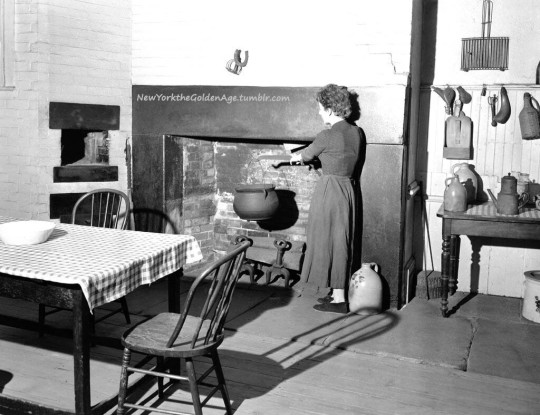
The fireplace and Dutch oven in the kitchen (at the back of the basement) in the Old Merchant's House, 29 E. 4th Street on April 5, 1954. The kettle, with a swinging arm, was still in usable condition. The small, square opening to the left of the fireplace is the Dutch oven.
The Old Merchant's House, built in 1832 and now the Merchant House Museum, still stands and is open to visitors. Below is a spread from a 1944 issue of House & Garden about the historic house. Click/tap to enlarge.
Top photo: Associated Press
Bottom photo: Merchant's House Museum
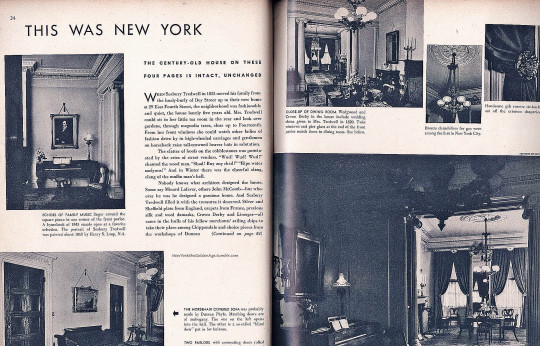
#vintage New York#1950s#1940s#historic building#Old Merchant's House#Merchant's House Museum#New York 1830s#historic preservation#19th century New York
29 notes
·
View notes
Text


Cream Silk Brocade Wedding Dress, 1830s, American.
Augusta Auctions.
#New York#Long Island#womenswear#Augusta auctions#silk#dress#extant garments#19th century#1830s#brocade#wedding#wedding dress#1830s dress#1830s wedding
46 notes
·
View notes
Text

Fifty years ago, New York was little more than a village; now, it is a fine city with three hundred thousand inhabitants. I have never seen any city so admirably adapted for commerce. It is built upon a narrow island, between Long Island Sound and the Hudson River, Broadway running up it like the vertebrae of some huge animal, and the other streets diverging from it at right angles, like the ribs; each street running to the river, and presenting to the view a forest of masts.
— Frederick Marryat, Diary in America
New York, from Brooklyn Heights, 1837 print after artist John William Hill. This is the year Marryat arrived in New York City to begin his American tour.
#frederick marryat#captain marryat#1830s#new york city#diary in america#1837#travelogue#john william hill#brooklyn heights#age of sail#age of steam
17 notes
·
View notes
Text
youtube
NEW YORK (1838)
#new york#new york city#nyc#1800s art#1800s#1830s#ferry#catamaran#old new york#vintage new york#vintage#old#old city#new york aesthetic#new york forever#new york hardcore#new york liberty#new york rp#new york times#new york post#new york news#new york mets#new york cafe#new york comic con#gangs of new york#martin scorsese#victorian#Youtube
0 notes
Text

The Oxbow (1836) by Thomas Cole.
0 notes
Text
Warren County and the Adirondacks
Warren County is one of many counties in the Adirondack region in northern New York (otherwise known as upstate New York), which has "100 welcoming communities, mountains, lakes, verdant valleys and steep cliffs," with Adirondack becoming lumber capital of the world as one book put it. Specifically, the Lake George Region with North Creek, Bolton Landing, and Lake George is featured as part of the Adirondack region. It is worth remembering that RBM I was born in this region and the Mills family lived, basically, in this region, itself. This county is important for the Adirondacks, and so much so that New York State describes the Adirondacks as an integral part of the region:
Warren County was named in honor of General Joseph Warren, an American Revolutionary War hero of the Battle of Bunker Hill. It includes the magnificent Lake George Area, in addition to the cultural hub of the City of Glens Falls and the hometown flair of surrounding Southern Adirondack towns and villages...Tourism is also thriving, with popular destination Lake George drawing thousands of tourists each year.
This brings us to an 1876 map of the "New York Wilderness." I have highlighted, specifically, the water routes (Hudson River from the south) are colored blue and roads colored yellow:
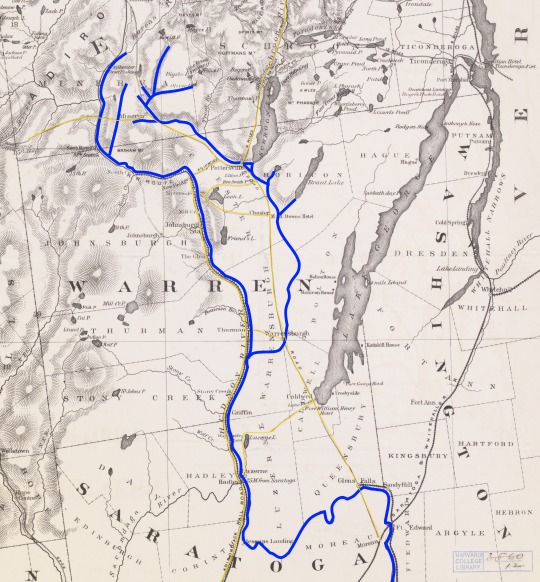
This post was originally published on WordPress in December 2018.
This is interesting. Discarding the railroads, as they were undoubtedly not there in 1835, this shows that water routes connect Glens Falls, Pottersville, Chester (basically), and Minerva, with an extensive road network as well. This would have made it easy for the Mills family to move from place to place and John Mills to be an effective miller or even a captain of a canal boat. This provides further context and support for the Mills family narrative outlined in earlier posts on this blog, especially John's journey to Warren County, which I've said in the past was up the Hudson River. Of course there are remaining questions and family mysteries, as I noted in the past, but maps like this give us another piece of the puzzle.
It also connects to a number of other realities. For one, John would have been one of the first settlers of Glen's Falls, which was not incorporated from Queensbury until 1839, four years after he arrived in Warren County. Furthermore, Warren County was relatively new. It had only been carved out of Washington County in March 1813. John could have easily gone up to Minerva to trade his supplies. It wouldn't be that hard. He would die and be buried not in the cemetery in Glens Falls but in Chester Cemetery in Chester, Orange County.
© 2018-2023 Burkely Hermann. All rights reserved.
#warren county#new york state#adirondacks#genealogy#family history#ancestry#wordpress#mills#mills family#maps#canal boats#canals#pottersville#chester new york#minerva new york#glens falls#1830s#1810s#19th century#cemeteries
0 notes
Text




Lovely lace designs.
The Lady’s Book. New York [etc: Godey Co. [etc.]., 1830
Feb. 1839
Godey’s Lady’s Book (Philadelphia, Pa. : 1840). Philadelphia, Pa: L.A. Godey, 1840.
May, 1841
Oct. 1854
AP2 .G56
#lace#lace making#sewing#clothing#design#art#embroidery#illustration#magazine#Godey's Lady's Book#Lady's Book#1800's#19th century#libraryofva#specialcollections#rarebooks
157 notes
·
View notes
Text
Vagabond
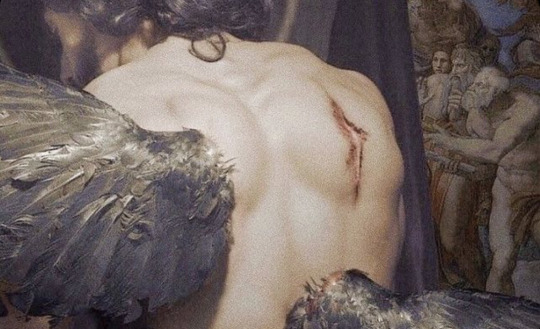
Vagabond — wandering from place to place without any settled home
Poly Lost Boys x GN Reader
Synopsis: Forgiveness is a fickle thing. When four souls find each other, the world finds its equilibrium once more; until the absence of another tips the scale forever. What happens when a familiar face shows itself back at the boardwalk after twenty years of absence?
Warnings: slight angst, lots of historical information in the beginning
Word Count: 3k
By issuing the Declaration of Independence, adopted by the Continental Congress on July 4th, 1776, the 13 American colonies severed their political connections to Great Britain.
You had been ten during the conflicts between America and Great Britain, young and impressionable. Your family came with Puritans, who set sail to America back in 1630. Unlike the Pilgrims, who had left ten years earlier, the Puritans did not break with the Church of England but sought to reform it. All that happened before you were born; your ancestors had settled down and spread their roots into American soil.
You recalled little of the American Revolution; after all, you were very young back then, but you remember December 15th, 1791, vividly. Your mother couldn't stop crying that day, and your father had pulled out the oldest whiskey they had that day. America was finally severed from the tyrannical rule of George III.
You came to understand the significance of those dates more as you aged, growing into a strong individual as you helped your family on their farm. You never intended to marry; it wasn't something you had ever desired or looked forward to. The same year you had gotten married was the day you lost your immortality; both events are related but not necessarily connected. You were introduced to the vampiric community in New Orleans, a city that used the day to sleep off the mistakes you made throughout the rambunctious night.
You had lived through the formation of the Constitution of the United States of America in 1787 when the founding fathers sought to implement more structure into the now independent country.
The infamous whiskey rebellion. American drunks apparently were not too keen about Alexander Hamilton implementing a liquor tax to try and raise money for the national debt; asserting the federal government's power back in 1794.
Only nine years later, the Louisiana Purchase happened in 1803. The small land purchase for only $27 million created room for the states of Louisiana, Missouri, Arkansas, Iowa, North Dakota, South Dakota, Nebraska, and Oklahoma, along with most of Kansas, Colorado, Wyoming, Montana, and Minnesota.
Throughout the 1810s and 1830s, you had moved on from New Orleans and left for New York, seeking human connections and reconnecting with the younger generations. During that time, the Battle of New Orleans in 1815 and the Monroe Doctrine in 1823 seemed to fly past you.
Then, signed on February 2nd, 1848, the Treaty of Guadalupe Hidalgo finally brought closure to the Mexican-American war. At this time, you were no stranger to political conflicts anymore, and the stench of blood and sweat staining battlefields was, unfortunately, no stranger.
Life moved on regardless, no matter the horrid realities life provided. For a short while, life had finally come to a stand-still, guns tucked away as the world in America resumed its development. Until April 12th, 1861, Confederate troops fired on Fort Sumter in South Carolina's Charleston Harbor at 4:30 A.M., A day that changed America forever, the beginning of the American Civil War.
The Emancipation Proclamation, The First Conscription Act, The Battle of Chancellorsville, The Vicksburg Campaign, The Gettysburg Campaign, The Battle of Chickamauga, The Battle of Chattanooga, The Siege of Knoxville. The list continued, and the coppery smell of wasted humanity tainted the air, the wind carrying the cries of victims throughout the nation.
The war ended in the Spring of 1865. Robert E. Lee surrendered the last major Confederate army to Ulysses S. Grant at Appomattox Courthouse on April 9th, 1865.
The number of soldiers who died throughout those four years eventually got estimated to be around 620,000.
Only 47 years later, on July 28th, 1914, the Austrian Archduke Franz Ferdinand was assassinated, beginning the cruel trench warfare of World War I. In early April 1917, America aided the effort to join a war to end all wars. You had entered the war effort, like everyone capable at the time; from soldiers to nurses, everyone gave aid.
On November 11th, 1918, the war ended. Although the Allies won, you found no reason to celebrate. Not when mothers sold their homes since there wasn't a reason to have a multiple-bedroom house anymore, when graveyards overflowed with the dead, when people mourned their losses, when mothers' only answer to their missing sons was a notice declaring their child missing in action.
The stock market crashed in 1929, kicking off the Great Depression that would last for more than a decade.
On September 1st, 1939, Germany invaded Poland. Kicking off World War II and beginning one of the most brutal warfare's, Blitzkrieg. On May 8th, 1945, Germany surrendered. After the atomic bomb was dropped on Hiroshima and Nagasaki, Japan surrendered on September 2nd, 1945, and the Second World War came to an end.
The war ended, and the surviving soldiers returned with missing limbs and broken spirits. You were a firm believer that humans were not meant to witness so much death; it tainted them; it dulled them. Although you were a vampire, a creature supposedly made for horror, you could not forget what you had witnessed in only the span of 21 years.
You were 201 years old now, relatively young in the grand scheme of time, but you had lived through a few of the greatest horrors the world had ever seen.
189 years of traversing the lands, you watched grow in a desperate search to find one of your own. Since you were turned and left New Orleans, you had not met a single vampire. You watched with sorrowful wisdom in your eyes as the world passed through you, virginity in people's expressions you wish you had. A gaze untainted by warfare, civil unrest, and brutality.
Although you have met the occasional human to brighten your own world, it did not cure you. Your search was desolate—fruitless.
Your feet had carried you to Santa Carla, the year now being 1963, and just as the five stages of grief had settled on acceptance. You bumped into a group of four rambunctious bikers that would change your life forever. That had been the first time you had met, and you had continued to live together, going on to live through the Civil Rights movement and grieving the assassination of Martin Luther King, Jr.
But on August 12th, 1967, you left Santa Carla. Your absence is only justified by a delicately written letter standing in your place. You had grown to love the boys, but you had lived differently compared to them.
Marko and Paul were younger vampires than you, having been turned while The Great Depression was bulldozing America. Dwanye had been older, abandoning his immortality in the 18th century along with David. All of them possessed the innate ability to move on from the past, a talent you, unfortunately, did not possess.
No matter how hard you tried, you could not find peace or excitement in the future. The uncertainty corrupted you, tormented you and your experiences, so you left. Not with the intent to abandon but to sort out whatever you had to sort out. Away from the prying eyes of those you loved, those who you did not want—couldn't disappoint.
Santa Carla, the town you had never been able to forget. It was 1987 now; twenty years had passed since you had seen the four vampires. You had missed them—a melancholic weight having nestled its way into your heart ever since you left. You regretted the way you had left through a simple letter. A cowardly move; you were wise enough to understand that. But at the time, you couldn't bring yourself to say it to them. How could you? Look someone in the eyes, someone like you—your own pack that never did anything but love you—and tell them you were leaving?
You didn't have the heart, and if you were a little more honest, you didn't have it now, either. But you missed them more than your hurt pride by walking what felt like a walk of shame as you wandered around the busy boardwalk. One thing you never could get used to was the constant shift in fashion, it felt like the ins became the outs overnight, and you never were able to keep up with it.
Bright colors were the most fashionable now, with teased hair and loud makeup. You enjoyed it, your knowing eyes watching over the crowd. The smell of hairspray permeated the air, wafting towards you as you passed people. Bulky and oversized clothes were spotted throughout the crowds, some men and women wearing specific member-only jackets. Ah, it seems the surfer nazis still haven't given up on Santa Carla yet.
The amusement park was new; back in 1867, the boardwalk had small shops littered around—like a market. Originally it mostly sold food and groceries, fish caught fresh from the sea, and farmers selling their produce.
How has the pier changed so significantly? If it wasn't for the bold, attention-seeking sign that said Santa Carla Boardwalk; you would've thought you were at the wrong address. But stepping on those old wooden floorboards of the pier that occasionally creaked or sunk under your feet was an all too familiar feeling. The smell of salt, rotting seaweed that had washed onto the shore, and the fresh street food made you feel all too at home.
It felt like you had never really left.
Your appearance had changed quite a bit since you left Santa Carla, so you didn't expect either the boys or Max to really recognize you. But although you were willing to stay under the radar for the boys, Max was another story. He was a head vampire, a coven leader, and therefore needed to be notified of your presence.
Entering Max's video store made you feel nostalgic, the same old grimy bell still hanging atop the doorframe signaling your arrival; you had been the one to put that there to originally annoy Max. You were surprised he kept it. The wooden floorboards and furniture gave off a distinct, homey smell. You had been there when the store was built, and the shiny coating across the floors now had grown mat, occasional wood panels brighter in color than before.
"I never thought I'd meet the day I saw you walk through those doors again."
Turning around, you met the stern gaze of Max. His outfit made you smile, a desperate attempt at blending in with the crowd. Max was always a stickler for blending in; if he had no intention of turning you; you had no business knowing who; or rather what, he was.
"It's good to see you."
"I'm flattered, but I doubt that I am the sole reason you returned." Max always carried that knowing tone, as if he's watched out every move you'd make before you made them. It reminded you that Max had a coven before the boys and you, one he rarely conversed about. Perhaps Max really had seen this turn out before, but analyzing that surprised expression, you could only assume who had left never did come back.
"How right you are," You sighed, shoulders dropping as you hopped onto the cashier counter. It was before opening, meaning you and Max had some time to chat privately.
"Twenty years is a long time," Max hummed, a low and almost chiding tone. "What made you come back?"
"To us, it isn't," You weakly argued back. The cumbersome feeling, or rather an awareness that you were in the wrong, was nearly unbearable. You were smart enough to understand that denial was a fruitless endeavor, and yet you couldn't help but let those desperate attempts escape you.
"For people waiting for you, it's an eternity." Max sighed in a calm but chiding tone. Although Max never did have to scold you the way he did with the boys, from not committing arson to preventing fights. Max instead focused his guidance towards you on a more emotional level, the morality; a bit ironic being taught by a vampire—but he did his best.
You glanced outside, through the glass walls of Max's shop, watching the bustling crowd pass you. Twenty years to a vampire was nothing, but somehow the short span of time felt arduous. Why did you come back?
"I never intended on staying away forever. I knew that when the time was right, I'd return." You explained, stealing a quick glance at Max. The older man had a frown etched onto his face, eyebrows furrowed as his own gaze lingered on the rambunctious humans outside. So unaware of the constant and unrelenting passage of time. It was cruel to be immortal; the passage of time no longer hindered you. But emotions are bendable and are the only aspect of ourselves that remains from who we were. Emotions were mortal.
"Santa Carla has changed, Y/N. It is not what you left behind; they are not the same as they were alongside you." Max recalled, his voice disapproving.
You knew Max was correct; you knew deep in your wrenching and twisting gut. You jumped off the counter, your feet hitting the floor like gravity had shifted around you, sinking your body into the floor. "I know," you knew; perhaps the boys didn't even want to see you; they could curse you out and send your name to hell for all eternity. They deserved to do it too.
But they loved you once, and perhaps you can't help shake the feeling that they might love you again this time too.
Max sighed, walking over to his front door and twisting the closed sign around, and pronouncing the store now open. Each tap of his foot, synced with his steps, was like a thundering echo inside you. It prompted you to get up and to provide closure for the others. You reach the door, opening midway before Max leaves you with some parting advice.
"I hope you find what you came here for, Y/N. But the time might be right for you now, but it might not be for them."
You nodded, not looking back as you walked out of the store. The air was warmer, humid from the ocean breeze mixing into the air, the notorious assassin for any styled and teased hair due.
Laughter was one of your favorite sounds. As cliche as that might sound, it felt rejuvenating to hear. Whether it was a loud cackle mimicking the call of a hyena or a high-pitched wheeze or whistle. There was a beauty in people's expressions, how their noses tended to scrunch up, or how others held their stomachs and nearly doubled over. Laughter was infectious, and you loved observing the dopamine spread to others. Strangers connecting over a similar sense of joy; there was a beauty in it.
The boardwalk was filled with it, people brushing shoulders against shoulders as they walked. Groups cackling and shoving each other as they enjoyed the youngness of the evening. Music booming from different directions, punks blasting the newest rap or metal music, hippies tuning out to a gentle jam, but the loudest seemed to be a distant concert down the boardwalk and closer to the pier. Like a bee sensing some honey, you followed. Dodging the occasional passerby, ducking out of the way from shop owners lugging their merchandise around.
The music got louder, and a small thread of excitement seemed to push you further, faster. Your small stroll transformed into a quickened step, your ears guiding you and your eyes following the crowd. The music was loud; a tight smosh-like pit had formed before the stage where people grind and brushed against each other to the beat of the music.
Looking around, you scanned the faces of teenagers and young adults. There was an eager but dreaded nervousness to your gaze at the thought of seeing a face that looked familiar. But it wasn't your eyes that caught their presence, but rather your sense of smell.
Copper.
Although it was harder to pick up when the wind stills its prancing, the occasional breeze led you further towards the pier. Away from the smosh pit, and where people stood to enjoy the music but not risk getting mulled over by a hormonal teenager.
There they stood, strikingly familiar. Although some of the fashion had changed, most of their originality stayed intact. That tiny red flag tied around Dwayne's waist was something the two of you had stolen from a stingy bar owner back in 1964; Markos jacket still had all too familiar patches sewn into its denim fabric; Paul still wore those bracelets you gave him, and David wore the most prominent reminder of you, his oversized coat.
The wind picked up around you, a cold and mocking breeze flowing through your hair and betraying your presence to the four men you had left behind all those years ago. One by one, heads lifted, smiling ceased, and laughter died. Although you had spent years preparing yourself for this moment, nothing felt so gut-wrenchingly real than standing before them.
How do you look someone in the eyes after you've abandoned them?
How do you move past that moment when the world around you stills and halts. When you lose yourself in the blear of the world when mortality reaches its hand around your heart and squeezes. A vice-like grip, a feeling blooming within your chest so heavy–so unspeakable. When you see those eyes, recognize the sorrow behind them and realize you were the perpetrator. You were the one who put that agony, that sadness there.
The burden of your actions ties itself around your throat like a noose, tight and unyielding, as you realize the cruelty was done by none other than yourself. And there is no way, in any shape or form, you could reverse the damage you've done. Pain is immortal, it might yield to its throbbing, but it never forgets.
A world with your boys back in 1967 exists now only in your memory. The four men, cold as the autumn waters, were your reality now.
"Hello, boys."
#the lost boys 1987#poly lost boys x reader#tlb#the lost boys marko#the lost boys david#the lost boys dwayne#tlb x reader#tlb paul#tlb david#tlb marko#tlb dwayne#dwayne tlb#paul tlb#marko tlb#david tlb#laddie tlb#star tlb#the lost boys star#the lost boys x reader#the lost boys#tlb fanfic#tlb x you#tlb headcanons#tlb imagine#the lost boys paul#the lost boys michael#tlb michael#michael x reader
469 notes
·
View notes
Text


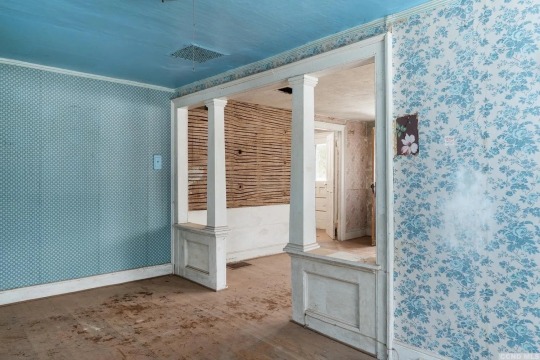



Lexington, New York
built in 1830
177 notes
·
View notes
Text
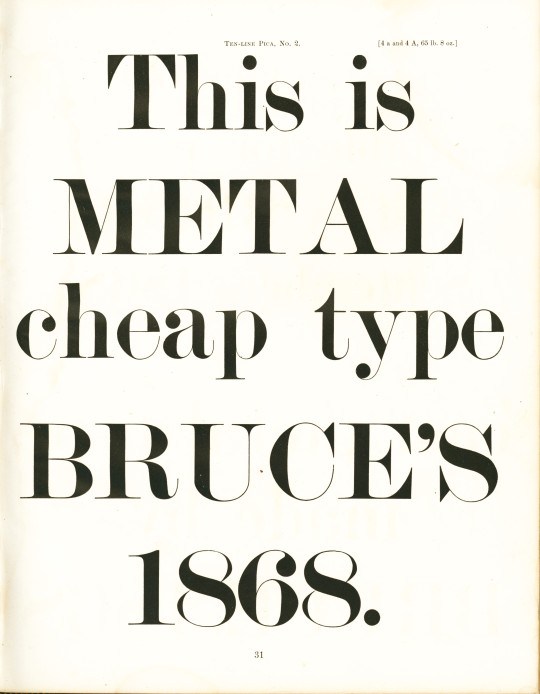



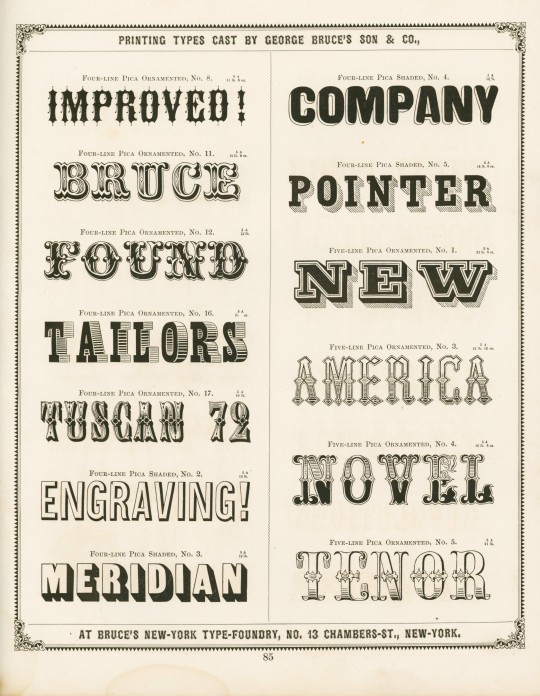
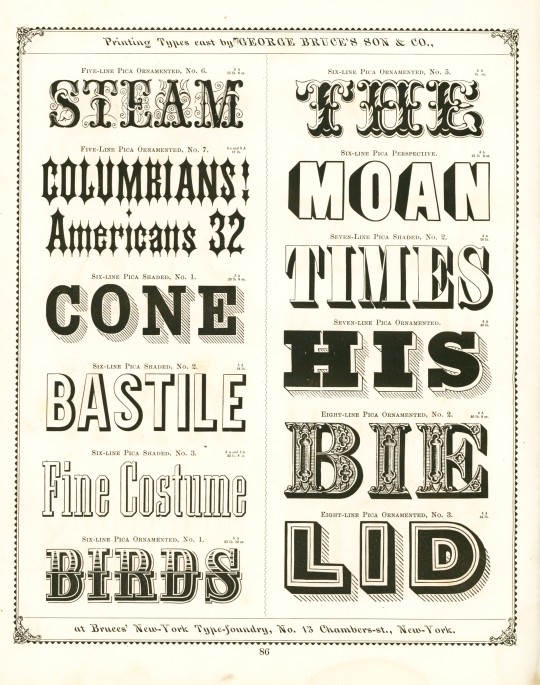




Typography Tuesday
New acquisition! A type specimen book from New York type foundry George Bruce's Son & Co., 1869. George Bruce (1781–1866) was a Scottish American printer and type founder. He and his older brother started off as type founders and printers in 1812 but jettisoned their printing business in 1816 to concentrate on founding type. His typefaces became widely popular among printers by the 1830s, and his company remained predominant for a generation. His son David Wolfe Bruce (1824–1895) took over the business after his father's death, and ran it until his retirement in 1890. The firm was eventually acquired, like so many other foundries, by American Type Founders.
View more Typography Tuesday posts.
#Typography Tuesday#typetuesday#George Bruce's Son & Co.#George Bruce#Type specimen books#type specimens#type display books#type founding#type foundries
239 notes
·
View notes
Text

La gare Grand Central de New York dans les années 1920, avant que la lumière ne soit bloquée par de grands immeubles. - source Lily Song Zhang via Golden Age Of Travel 1830-1955.
88 notes
·
View notes
Text

It's been 10 yrs. and the 1830 windmill house in Amagansett, New York is still on the Market. In my opinion, it's the price. The home is small, just 2bds, 1ba, and is priced at $12M.


The home needs a refresh and some color, but it's as cute as a button.

The kitchen's cute, but very dated. This house could look adorable.

Bedroom #1 is bright and has doors to the garden.

The bath has a nice large shower.

Bedroom #2 has the stairs that lead up to the windmill, and it also has some great beams.

This is what I'm talkin' about. When people remove the workings of an old windmill to make a house it makes me crazy. This one is intact.

They've installed a fan b/c it must get pretty hot up here.
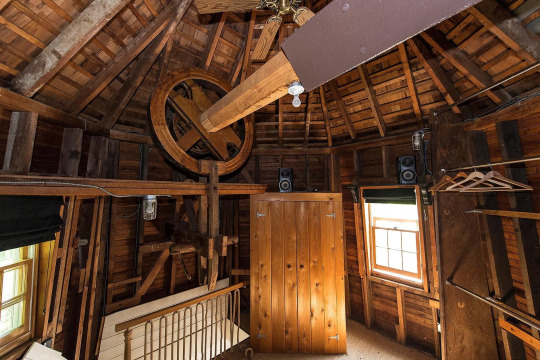
The best part is that you can actually come up here and make a cool room, but most people use it as a closet.


The grounds are absolutely stunning. Look at the private road up to the house, alone.


There're 5.45 acres of land, which probably factor into the high price.

There's a brick patio under a beautiful big tree near the house.
120 notes
·
View notes
Text


Moses Eaton Jr.
Sample Box and Ten Panels. Dublin, New Hampshire c. 1820–1830
Paint on pine, with brass handle
Box: 8 3/4 x 15 1/16 x 2 5/8" Panels: 14 x 6 7/8 x 1/8" each
Collection American Folk Art Museum, New York
Anonymous gift and gift of the Richard Coyle Lilly Foundation, 1980.28.1a–k
Photo by Terry McGinnis
129 notes
·
View notes
Text

Today we have door 18 and here we have an East Indiaman. A fragile beauty hiding in Salem- The Friendship of Salem

Friendship of Salem
More about her:
The original Friendship, a two-decked, three-masted, square-rigged, 342-ton vessel was built from 1796-1797. The ship was constructed in the Stage Point yard of Salem shipbuilder Enos Briggs across the South River from today's Salem Maritime National Historic Site. Friendship was launched on 28 May 1797 and registered at the Salem Custom House to merchants Aaron Waite (1742-1830) and Jerathmiel Peirce (1747-1827).
Friendship was an “East Indiaman,” the type of merchant ship that was used in the East Indies trade in the years after the American Revolution. Friendship made 15 voyages to countries including China, Indonesia, India, Venezuela, Spain, and Russia. The cargo brought back to Salem consisted of pepper, silk, sugar, coffee, ale, sherry, tin, salt, cheese, candles, and other goods and merchandise.
On 5 September 1812, Friendship was returning from Archangel, Russia, when the ship was captured by the British sloop of war HMS Rosamond. The War of 1812 between the British and the United States began while Friendship was in Archangel, Russia. The war had started in June, but the captain and crew were unaware of that fact and set off for Salem, only to be captured in the Atlantic Ocean and taken as a prize of war. The captain and crew were able to return to Salem, but Friendship was sold at auction in London, England on 17 March 1813.
The replica tall ship, is docked at Derby Wharf and was designed to present the appearance an original 1797 Salem-built vessel. The keel was laid in Scarano Shipyard in Albany, New York in 1996 and uses modern technology and materials to meet today’s safety and accessibility requirements.
She represents New England’s influential role in the development of global and domestic maritime trade and in the economic and political development of the United States.
#naval history#naval artifacts#friendship of salem#tall ship#advent calendar#day 18#age of sail replica#18th century
123 notes
·
View notes
Text

Meet Anna Murray Douglass, first wife to Frederick Douglass. Anna helped him escape enslavement. Anna was the first of her siblings to be born free after her parents were manumitted. When she met Frederick she was financially prepared to start a life with him but first, he needed freedom. By borrowing a freedman’s protection certificate from a friend and wearing the disguise of a sailor sewn by Anna, Frederick made his way to New York City by train, spending Anna’s money to buy the ticket. She continued to support his abolitionist work for the rest of her life. There is no Frederick Douglass without Anna Murray Douglass. Protect Black women at all costs.
Anna Murray Douglass was an American abolitionist, member of the Underground Railroad, and the first wife of Frederick Douglass, from 1838 to her death.
In the 1830s, when a teenaged Frederick Augustus Washington Bailey was enslaved in the Baltimore household of Hugh Auld, teaching himself, painstakingly and largely in secret, to read and write, a young Black woman named Anna Murray was also at work in that city, shouldering the domestic labor of white households.
The families of both these young people had been torn apart by the practice of slavery. Frederick had been separated from his mother so early his memories of her were mere shadows and fragments, and again parted from his maternal grandparents as a young child, “given” by the owner of his plantation birthplace on Maryland’s Eastern Shore to a family member in Baltimore. Anna was the eighth of 12 children—the first who was born free, just a month after her parents’ manumission in rural Denton, MD. She moved to Baltimore at 17 to earn a wage.
It was around this time that Anna and Frederick met, perhaps in church (the details are lost to history), and hatched a plan. Frederick took a train to New York City using false papers, Anna followed shortly after, and the two married there in the home of abolitionist David Ruggles in 1838.
62 notes
·
View notes